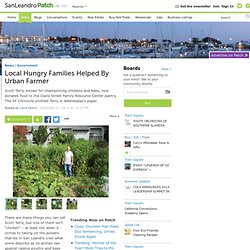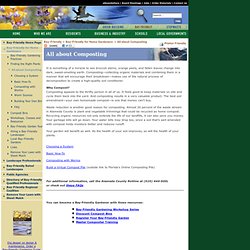

Pick. Your source of daily updated funny pictures and gifs. Sanleandro.patch. Scott Terry, known for championing chickens and bees, now donates food to the Davis Street Family Resource Center pantry.

The SF Chronicle profiled Terry in Wednesday's paper. There are many things you can call Scott Terry, but one of them isn’t “chicken” – at least not when it comes to taking on the powers-that-be in San Leandro over what some describe as its archaic law against raising poultry and bees within city limits. The 47-year-old financial planner and a cohort of about a half dozen other San Leandro hen lovers are part of an informal underground network of residents who admit they are running afoul of the law but are dedicated to seeing it changed.
Terry currently cares for three egg-laying hens and two hives of bees at his home in his Broadmoor neighborhood. He is doing so illegally, but not entirely hidden from city authorities. His chickens have names. Unabashed bee lover You can read prior Patch coverage of the whole controversy . Food donations Helping hands & 4-H Club. 15 houseplants to improve indoor air quality. All about Composting. It is something of a miracle to see broccoli stems, orange peels, and fallen leaves change into dark, sweet-smelling earth.

Composting—collecting organic materials and combining them in a manner that will encourage their breakdown—makes use of the natural process of decomposition to create a high-quality soil conditioner. Why Compost? Composting appeals to the thrifty person in all of us. It feels good to keep materials on site and cycle them back into the yard. And composting results in a very valuable product. Waste reduction is another good reason for composting.
Your garden will benefit as well. Choosing a System Basic How-To Composting with Worms Build a Virtual Compost Pile (outside link to Florida's Online Composting Pile) For additional information, call the Alameda County Rotline at (510) 444-SOIL or check out these FAQs You can become a Bay-Friendly Gardener with these resources: Growing Your Own Garlic - Planting Growing Harvesting and Storing Garlic. As far as I'm concerned, garlic gets the blue ribbon for growing your own.

It's absurdly easy to plant and care for; it tastes great; it looks beautiful and it takes up so little ground that even those with very small gardens can raise enough to be self-sufficient in garlic for a good part of the year. All you have to do is choose the right varieties; plant at the right time, in the right soil; then harvest when just right and store correctly. 1. Choosing Types of Garlic If you look in a specialist catalog like the one at Gourmet Garlic Gardens, you'll find dozens of varieties of garlic listed. You see where this is going – and you can see a lot more types of garlic on either of those websites, but for general purposes the most important difference is the one between softneck and hardneck. Softnecks are so called because the whole green plant dies down to pliancy, leaving nothing but the bulb and flexible stems that are easy to braid.
Gardeners in most of the U.S. can try some of both. 2.